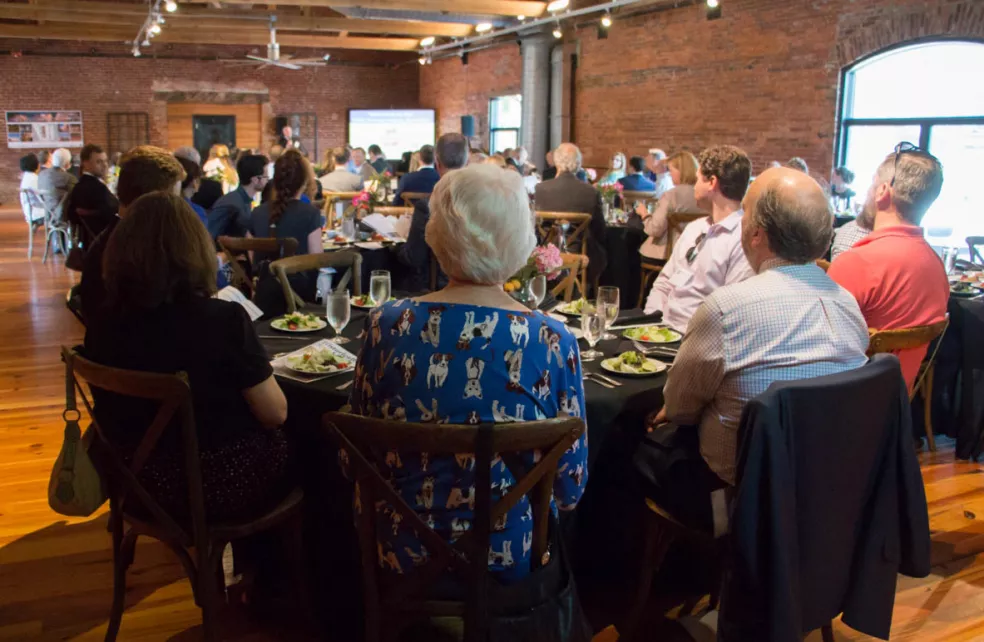2018 Preservation Award Winners
Thursday, May 3rd 2018

We're excited to announce the recipients of our 2018 Preservation Awards. Each May, in conjunction with National Preservation Month, we present these awards to celebrate the accomplishments of local property owners; professionals in the fields of architecture, construction and design; and leaders who champion preservation as an opportunity to support the Midlands’ economy and culture. These awards, presented on Thursday, May 3 at our annual Preservation Awards Luncheon, encourage and promote the importance of local preservation.
“Congratulations to our 2018 Preservation Award recipients for leading the way in preserving Columbia’s built history for future generations,” said Robin Waites, Historic Columbia’s executive director. “While we can use our research and experience to craft the case for preservation – these leaders in preservation are the ones who provide the financial, creative and sweat equity to make the advocacy worth it.”
Historic Columbia honored the following recipients in the areas of Preservation Leadership, Preservation/Restoration, Adaptive Use and New Construction in a Historic Context. See photos of this year's award winning projects.
Preservation Leadership Award
Award Overview
Nominations in this category will recognize an individual, corporation, governmental agency, community or neighborhood association that has contributed to the advancement of historic preservation in the region.
2018 Winner
Waverly Neighborhood Association
Waverly Neighborhood Association
Bounded by Harden, Taylor and Gervais streets along Millwood Avenue, the Waverly Neighborhood emerged from a former antebellum plantation into an area that was a bustling hub of African American life in the early to mid-20th century. In 2005, Waverly elected to become an historic district to protect what remained of its original vernacular and dynamic architecture. Eleven years later in 2016, its citizens became the first protection area in the city to strengthen their guidelines to further protect Waverly's historic integrity. While the process was not without conflict, the neighborhood was steadfast in its determination and vision for itself. Waverly is to be celebrated for garnering support to sustain their buildings, which continue to represent the important history of this community. They are a model of community engagement and neighborhood pride.
Adaptive Use
Award Overview
Structures rehabilitated with sensitivity to the historic fabric that function in a way that is different from its original intent.
2018 Winners
- 1402 Jim Hamilton Blvd (Curtiss-Wright Hangar)
- 2238 Sumter Street (Indah Coffee / Circa Barber Shop)
- 1621 Main Street (The Grand / Robinson Building)
- 2025 Barnwell Street (The Parker Annex)
- 2428 Main Street (Studio 2LR/Wilson Upholstery Building)
1402 Jim Hamilton Boulevard, Curtiss-Wright Hangar
Owners: Hangar Owner LLC (Will Brennan, Robert Lewis, Scott Linaberry and Chris Rogers)
Architect: Brennan Works
Contractor: Buchanan Construction
Constructed in 1929, the Curtiss-Wright Hangar remains one of the few extant and unmodified examples of a Curtiss-Wright designed hangar in the United States. During its early years, the building boasted not only entertainment air shows, but also visits from Amelia Earhart and President Franklin Delano Roosevelt. Developers retained the character defining elements of the historic structure and integrated them into the building's new use, including the large sliding door, exposed metal trusses and window frames. A new roof, which is a near match to the original, and new panes of glass are among the few things that were replaced during the process. The hangar is now home to Hunter-Gatherer Brewery.
2238 Sumter Street, Indah Coffee/Circa Barber Shop
Owner: Cason Development Group
Architect: Seed Architecture (John Powell)
Contractor: Montgomery Construction Company
Built for Dunn Electric in the early 1940s, the structure at 2238 Sumter Street continues to serve the evolving Cottontown neighborhood. The building's façade was retained, bricked-up windows re-opened, and the Dunn Electric mural signage restored. The front-most retail space was redesigned for use by Indah Coffee as an open-concept coffee counter. Overhead, the original ceiling frames and bow truss roof structure were exposed to open the space and showcase the construction methods typical of the era. In addition to Indah Coffee's first brick and mortar establishment, 2238 Sumter also houses Circa Barber Shop.
1621 Main Street, The Grand/Robinson Building
Owner: G. Scott Middleton
Architect: Lambert Architecture
Contractor: Mashburn Construction
From grocers to retailers to Columbia's leading Vaudeville house, the Robinson Building has undergone multiple transformations since its construction in 1866. Now home to The Grand, 1619-1621 Main Street has been restored to showcase rich historical detailing, both inside slip-over façade and out. The façade, which was previously covered by wood, was restored and given a decorative wood cornice as well as "eyebrows" over the second-story windows. Restoring the significant historic fabric of the building, the wooden trusses (damaged in a recent fire) were cleaned and restored and new tongue and groove decking was added. The Robinson Building is now home to a boutique bowling alley, The Grand, on the ground floor and a luxury apartment on the second story.
2025 Barnwell Street, The Parker Annex
Owner: Diversified Development, Inc.
Architect: Studio 2LR (Gretchen Lambert)
Contractor: Hood Construction (exterior) / Buchanan Construction (interior)
Constructed around 1910 as over ow housing for the State Hospital, the Parker Annex is the last remaining building on the Bull Street campus built exclusively for African American patients. The large double-hung windows, original to the building, were saved and restored during the renovation. The interior of the building was badly damaged from years of neglect. When the second-floor ceiling was removed, the original wooden roof trusses were revealed and discovered to be mostly intact. Because of this, the decision was made not to reinstall a ceiling. Instead, the space in between the first and second floors was left open, exposing the overhead piping as well as the underside of the second-story floorboards. This building is now used for commercial office space.
2428 Main Street, Wilson Upholstery Building/Studio 2LR
Owner: Noma Properties (Gretchen Lambert)
Architect: Studio 2LR Contractor: Buchanan Construction
The former Wilson Upholstery Building now houses the offices of Studio 2LR, an architecture and interiors firm. The building's old garage doors were removed and replaced with storefront windows and a new entry door. Painted signage from the days of Wilson Upholstery was maintained on the exterior of the building as a nod to the past. The steel windows were abated, refurbished and reinstalled in their original openings. The concrete slab flooring was cleaned but kept as-is to show the character acquired over years of use.
Preservation/Restoration
Award Overview
Historically significant structures restored to their original design and function.
2018 Winners
- 1633-1635 Main Street (Lula Drake/Seegers-Habenicht)
- 4017 Kilbourne Road
- 301 South Saluda Avenue
1633-35 Main Street, Seegers-Habenicht
Owners: CLM Properties (Martha Fowler, Robert Lewis, Katie Fowler Monoc, Jeff Prioreschi, Tom Prioreschi and Chris Rogers)
Architect: Charlie Baker
Contractor: Blackstone Construction (Don Blackstone)
Built in the aftermath of the Civil War, John C. Seegers' and Christopher C. Habenicht's saloon and brewery opened in late 1865. In 2015, CLM Properties bought the property, returning it to the family of its original owners. Based on a family photo, the owners working with the architect and the City of Columbia's Preservation office, carefully rehabilitated the façade to its original 19th century appearance. The second story windows, which were boarded up for decades, were reopened with custom Italianate windows installed on the first floor. During renovations, several sections of the original tile designs at the building's entrance were uncovered and since have been restored. Today, the narrow, Italianate style building houses Lula Drake Wine Parlour, Pilates Bodies By Victoria and the Pastor's Study.
4017 Kilbourne Road
Owners: Andrew and Katie Gainey
Architect: Jackson Miller & Associates, Robert N. Jackson
Contractor: Cosmetic Concrete (Jamie Poston)
Built in 1959 for Judge Lester Bates Jr. by Columbia architect Robert N. Jackson, this mid-century ranch house was a labor of love for homeowners Andy and Katie Gainey. The couple removed the existing carpets and refinished the floors by hand using period-appropriate material. The sunroom (a later addition) was opened to create a wide patio space, which opened into the backyard. The home's doors, previously painted, were stripped of layers of varnish to reveal beautiful birch wood underneath. The couple refurnished the home with mid- century furniture from Knoll, Eames, McCobb and others. The overall effect is that of stepping into a time capsule.
301 South Saluda Avenue
Owners: Mira and John Howard
Architect: Seed Architecture (John Powell and Laura Burns)
Contractor: Palmetto Construction and Renovation (Jim Evatt)
Homeowners Mira and John Howard began renovations to their craftsman bungalow in May 2017. The home was remarkably well preserved, retaining the majority of its original lighting and plumbing fixtures, doors, windows, molding, replaces and countless architectural elements. Every effort was made to source period-appropriate materials and finishes. In the kitchen, the island countertop was crafted from a century-old pecan tree taken from the home's backyard.
New Construction in a Historic Context
Award Overview
New buildings in an historic district adjacent to or within existing historic structures that complement the historic context.
2018 Winner
- Green Tree House at Wavering Place
- Shandon Presbyterian
Green Tree House at Wavering Place
Owners: Weston Adams III and Robert Adams VI Z
Architects: Boykin and Munnerlyn, Lisa Boykin Adams & Jody Munnerlyn
Contractor: Paul Hayes Construction
Constructed as an open-air pavilion, Wavering Place's Green Tree House marries the site's historic fabric with the rolling landscape. In keeping with existing materials on the property, the new facility uses both new and reclaimed wood in its delicate design. The structure's siding was salvaged from an old railway warehouse that had been moved to the property more than 30 years ago. Although the warehouse itself could not be saved, the material was given new life in the pavilion. The structure's stucco chimneys are a nod to the basement level of the main house, built circa 1850. Its metal roof also unifies it with other outbuildings on the property. True to its roots, the building even draws its name from the site-Green Tree was the original moniker for Wavering Place.
Shandon Presbyterian
Owner: Shandon Presbyterian Church
Architect: Lambert Architecture
Contractor: Hood Construction
Established in 1916, Shandon Presbyterian Church sought to restore its sanctuary in preparation for its 100th anniversary. The extensive renovation aimed at stripping the space back to its original 1916 appearance while adding modern amenities. A new wood ceiling inspired by similar sanctuaries of the era was added to improve acoustics. The border within the stained-glass windows was repeated in the design of the chancel flooring. The site's original hardwood floors were stripped of their carpeting and beautifully restored. Certainly, the most notable aspect of the renovation was the chancel, which was doubled in size. This expansion allows for better wheelchair accessibility, increased choir loft capacity and improved acoustics.


































